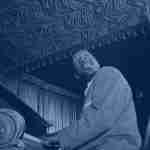They say that time is money, but in jazz improvisation, it’s even more than that! Time is what’s passing by while you’re desperately trying to recall the next chord change in a tune, the notes to the melody, or what to play at any given moment of your solo…
Everything in jazz improvisation happens in real-time. There’s ZERO time for thought or analysis. This is not the world of composition where you can dwell on musical problems for days until you come up with a solution…this is the world of improvisation where all you have is right now.
So how do you transcend the need to think and develop the skill to access everything you need in the moment?
Enter visualization – The necessary process to ingrain chords, progressions, chord-tones and more on a deep level.
But before we dive into visualization, first run through this quick quiz just to give you an idea about how big this problem really is. Grab a sheet of paper and record your answers and response times for each of these questions:
- What’s a ii V in the key of F# major?
- If the V7 of a ii V progression is Ab7, what’s the ii chord?
- What’s a iii Vi in the key of Db major?
- If the ii chord of a ii V progression is C# minor, what’s the V7 chord?
- If the ii V of a key is F- Bb7, what’s the VI7 of the key?
Now, judge your answers based on whether you were correct and how FAST you knew the answer.
Did any of the questions take you more than a split second?
And be honest with yourself…
Chances are, a couple of these questions took at least a few seconds for you to answer. You may not think that a few seconds is a big deal, I mean, you got the correct answer, right?
But the problem is that even after a second of thought your creative flow is disrupted, causing you to lose your place and your melodic continuity.
Let’s figure out how you can use visualization to get rid of the creative roadblocks…
What chord independence really means
Why is it so difficult to quickly mentally access some chords, while others seem to be super easy?
Much of the time, we expect to encounter a group of chords in the same way over and over. For example in the case of a ii V I, after A- we expect to get D7, and after D7, we expect we’ll progress to the I chord, G major.
But most jazz standards combine, modify, and alter these basic chord progressions like ii Vs in slightly unpredictable ways…
These subtle rearrangements or alterations of chords make us think just enough to throw us off balance for a moment.
For instance, after D7 in a ii V I, the progression may continue to a iii Vi of the key instead of resolving to the tonic.
Or perhaps, you’re playing over a bar of D7 and you want to play a ii V (A- D7) over that bar instead.
Well, to accomplish these feats in real-time, you have to have the information at your fingertips.
Chord independence is all about understanding how each chord fits into the over-all progression, while at the same time understanding how it relates to the key.
Take E7 in the key of G major for instance…you instantly need to know…
- It’s the VI7 chord of the key
- It’s frequently a part of a iii VI7 progression
- The iii chord that pairs with the E7 is B-
- The ii V it progresses to is A- D7
This is all stuff that should be SO accessible to your mind that you could be watching television while reciting the alphabet and doing jumping jacks, and STILL be able to have all this knowledge at your disposal.
Get my drift?
Visualization key by key
Visualization is the secret to getting chords operating in your mind and body on a visceral level. However, there’s a particular way to use visualization to soak up the fundamental chord progressions. The way is to focus on one key at a time.
Today, we’re sharing 10 Visualization Exercises with you that will help you master your chord progression fundamentals.
By drilling these ten exercises, you’ll greatly strengthen the key you’re working on and will then be able to recall any part of the fundamental progressions in any order or context.
And it’s really easy to start working on these…as you lie in bed at night, right before you go to sleep, pick a key. Then go through the 10 exercises in that key. Over time, make it a point to memorize the exercises so you don’t even need to look at them. You’ll just select a key and start working on it in your mind.
Take your time, and remember, one key at a time for all 10 exercises.
1.) Visualize a ii V progression clearly in your mind’s eye.
2.) Visualize just the V7 chord resolving to the tonic
3.) Visualize the iii VI
4.) Visualize the VI moving to a ii V
5.) Visualize the tonic moving to V7
6.) Visualize the tonic moving to VI7
7.) Visualize the tonic moving to a ii V
8.) Visualize the tonic moving to iii VI
9.) Visualize a iii VI ii V
10.) Visualize a ii V iii Vi
Quiz Yourself Constantly
Once you work on these key-by-key visualization exercises for a while, start mentally quizzing yourself on the fly in a similar manner as the quiz presented at the beginning of this lesson.
Do this while you ride the train, while you wait for the dentist, while you’re walking to class…you can do this ANYWHERE!
Grab the first chord that pops into your head and start asking yourself for some sort of related chord. For example, perhaps B7 comes to mind, so ask yourself what the ii chord would be if the B7 were the V7 chord?
Or maybe Db major pops into your mind, so ask yourself, what’s the V7 chord? You can do these simple mental quizzes anywhere and they’ll make your recall dramatically faster and your understanding of progressions much deeper.
Next time you’re commuting, exercising, or just lying in bed, run through some key-by-key visualization with a few quizzes thrown in there. A few minutes a day and you’ll become way more solid thinking and playing in all keys.























